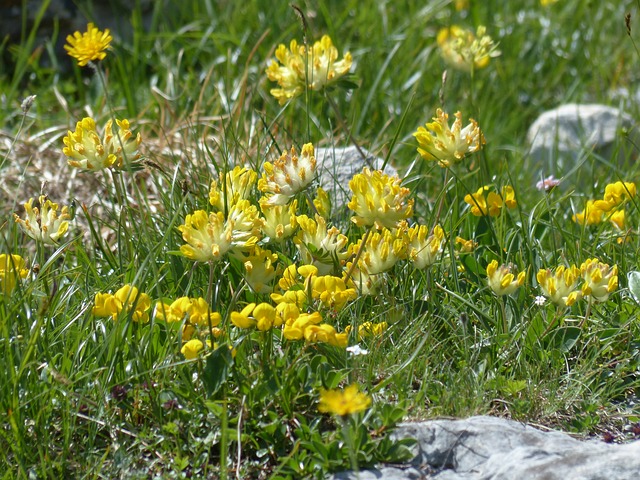 |  |  |  |  |
 |
Anthyllis vulneraria is a biennial (more commonly perennial) plant of the genus Anthyllis, typically reaching a height of 45–55 cm. It has a branched root system with a main taproot from which several ascending shoots emerge. The stems are upright, leafy, thick, and sturdy, usually numbering from 1 to 6. Both stems and flower stalks are covered with short, sparse, appressed hairs along their entire length.
The plant has imparipinnate (odd-pinnate) compound leaves that are hairless toward the top and densely pubescent toward the base. A distinctive feature of the upper stem leaves is the terminal leaflet, which is noticeably larger than the lateral ones. The flowers are papilionaceous (butterfly-shaped) and come in shades of orange, yellow, or red. The flower formula for Anthyllis vulneraria is: K5 C1+2+(2) A(10) G1.
The inflorescences are capitate (head-like), gathered in clusters of 2–3 at the top of the stems. These dense heads are surrounded by palmate-lobed bracts. The calyx is bicolored, dark purple in the upper part, and formed by 3–5 fused sepals that become inflated as the fruit develops. The corolla is usually orange or yellow.
The ten stamens are typically fused into a single bundle. The fruit is a single-seeded, indehiscent, ovate pod enclosed within the calyx. The pods are hairless, with a net-veined structure, and are truncate at the top. Seeds are oval and brown in color. The plant flowers from June to July and produces fruit in August. All species of Anthyllis are palatable to livestock, especially goats and sheep.
Harvesting of Raw Materials
The medicinal parts of Anthyllis vulneraria include the aerial parts — stems and leaves — as well as the flowers, collected during the plant’s flowering period, which typically occurs in June and July. The above-ground portions are carefully cut near the base and tied into small bundles for drying under shelter.
In some cases, the herb and flowers are first chopped and then spread in a thin layer on canvas or cardboard to dry. The harvested material should be stored in a dry, dark place, preferably in cardboard boxes or glass jars, and kept for no longer than two years.
Chemical Composition
Anthyllis vulneraria contains a variety of biologically active compounds, including tannins, flavonoids, vitamin C, saponins, organic acids, mineral substances, pigments, and essential oil. Ascorbic acid and carotene have been identified in the stems and leaves. The leaves also contain proanthocyanidins (prodelphinidin) and a diverse group of flavonoids such as kaempferol, quercetin, gossypetin, isorhamnetin, rhamnetin, 5-deoxykaempferol, phloretin, rhamnocitrin, kaempferol 3-O-galactoside, 5-deoxyrhamnocitrin, among others.
The flowers of the plant contain anthocyanins, including peonidin, cyanidin 3-galactoside, and delphinidin. The seeds are rich in carbohydrates and their related compounds, such as galactomannan and polysaccharides.
Pharmacological Properties
The medicinal properties of Anthyllis vulneraria are attributed to its rich chemical composition. The plant exhibits antiseptic, blood-purifying, wound-healing, detoxifying, and other therapeutic effects.
For instance, its tannins provide valuable astringent properties, while the presence of tannins and vitamin C—known for their bactericidal action—make the plant effective as an antiseptic. Additionally, the flavonoids found in the herb have a beneficial effect on the vascular system, contributing to vessel-strengthening and wound-healing activity.
Traditional Medicine Uses
Cosmetic use
In cosmetology, an infusion of Anthyllis vulneraria flowers is widely used to promote hair growth. For this reason, the plant is included in the formulation of certain shampoos, hair balms, and masks.
